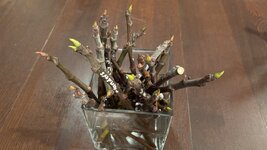Christmas was early this year! I just received a stack of 30 cuttings today (fully lignified it seems, but NOT dormant -> some bled some latex when I cut them).
After bleaching them, rinsing them off under warm tap water, and cutting off the bleached ends, I plan on pre-rooting them for a couple of days in water and then wrap the above-soil in Parafilm, scratch them, put some Clonex gel on and switch to 4x9 pots with pre-wetted (5:1) Professional Growing Mix #4 (peat moss with Perlite). I plan on keeping them under limited light (to prevent them from leafing out before they have roots) on a heating mat at 77 deg.F. in a covered Sterilin grow box.
Most if not all of the cuttings I did a couple of weeks ago, have rooted (I have yet to find one that rots), but thus far... only the ones that did NOT have an apical bud (I like to call them "stump cuttings") leafed out. I can imagine that due to "apical dominance", the ones that still have the "sharp top" do not push the lateral buds much. If these work out, I figure it might be through the apical bud taking off.
What do you experts do, if you have the choice? Cut off the apical bud and work with a "stump cutting", or leave it on (wrapped of course)?
After bleaching them, rinsing them off under warm tap water, and cutting off the bleached ends, I plan on pre-rooting them for a couple of days in water and then wrap the above-soil in Parafilm, scratch them, put some Clonex gel on and switch to 4x9 pots with pre-wetted (5:1) Professional Growing Mix #4 (peat moss with Perlite). I plan on keeping them under limited light (to prevent them from leafing out before they have roots) on a heating mat at 77 deg.F. in a covered Sterilin grow box.
Most if not all of the cuttings I did a couple of weeks ago, have rooted (I have yet to find one that rots), but thus far... only the ones that did NOT have an apical bud (I like to call them "stump cuttings") leafed out. I can imagine that due to "apical dominance", the ones that still have the "sharp top" do not push the lateral buds much. If these work out, I figure it might be through the apical bud taking off.
What do you experts do, if you have the choice? Cut off the apical bud and work with a "stump cutting", or leave it on (wrapped of course)?
Attachments
Last edited:

